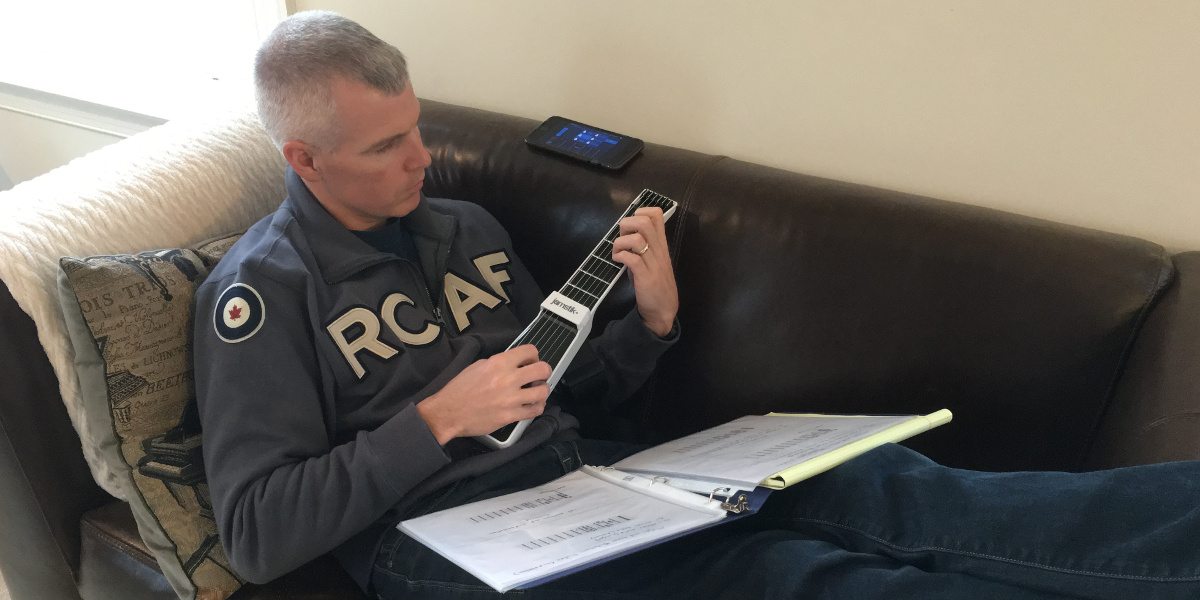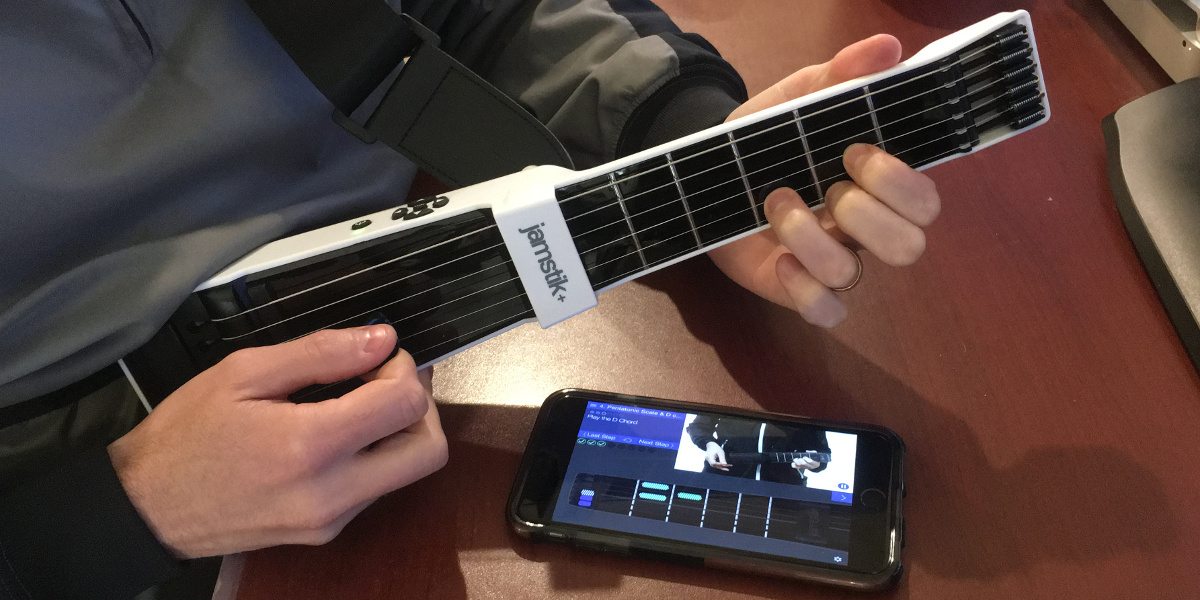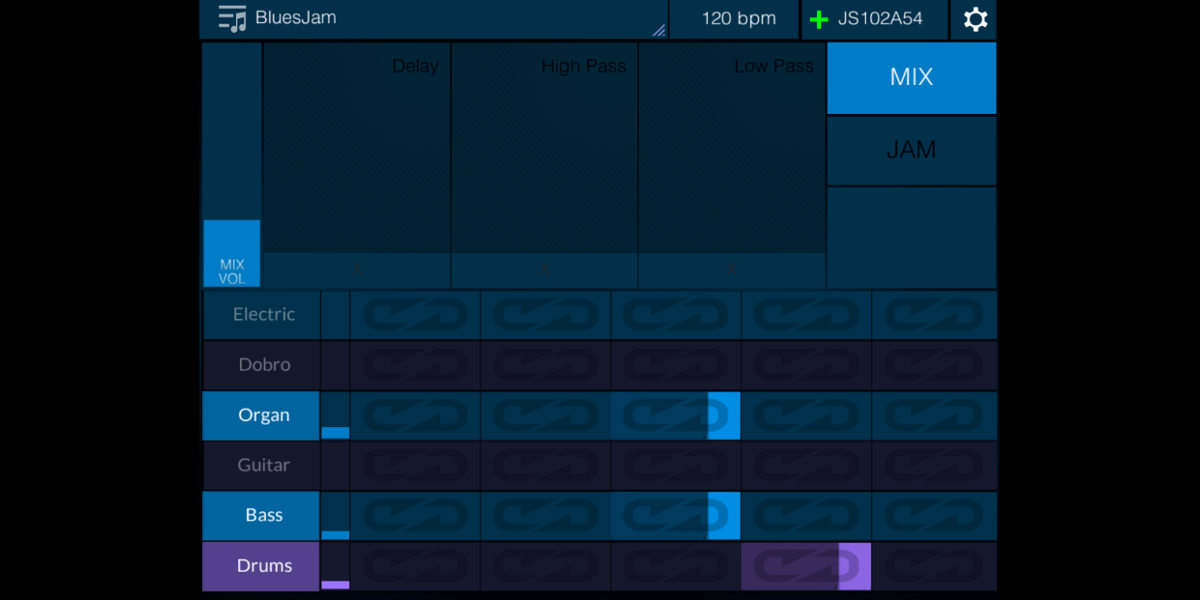The jamstik+ is the second iteration in the jamstik line. For those who missed the first version, the jamstik is a portable wireless midi instrument meant to mimic a guitar. It has five frets, enough to allow the playing of a wide variety of music, and allow the learning of barre chords. A highly successful Kickstarter, the “+” edition improves on the original, notably by moving the communication from an awkward ad-hoc wifi network to Bluetooth, but also by improving some mechanical aspects, such as adding magnetic pickups to make it feel more like a genuine guitar.

As a midi instrument that connects over Bluetooth, the jamstik+ makes its music through apps on a connected device, be it your tablet, phone, or desktop machine. (Currently, some software is iOS-only, though Zivix reports that they are working on Android and Windows support as well.) This means that it can work with any number of apps, as long as they are midi Bluetooth apps. Conversely, the official Zivix software for the jamstik+, specifically jam Tutor and jam Mix, both have splash screens stating “Best played with the jamstik,, as they can work with any midi instrument. What this means is that your experience with the jamstik+ is a mix of the hardware and the available software, and what you can get out of it depends on both.
The jamstik+ version we were sent included a carrying case, an item that is an additional purchase and should be factored into your plans given that a part of the jamstik+’s appeal is its easy portability. Initial hardware setup was easy: inserting the rechargeable battery, some minor customization choices, and attaching the strap took just a few minutes. Figuring out how to connect it to my iPhone took a bit more time. The key is that, unlike your other Bluetooth devices, the jamstik+ doesn’t connect from your Bluetooth settings. Instead, you download the jamstik+ app and connect through its interface.
This was somewhat confusing at first as I wasn’t certain how to connect within the other apps. It also wasn’t helped by some conflicting documentation on how GarageBand connects to midi devices. (GarageBand now hides this in its advanced settings until you enable “Run in Background”). The short story is that you can connect once with the jamstik+ app and it will usually work in other apps, but expect to fumble around a bit with this while you figure it out.
Using the jamstik+
Once set up, using the jamstik+ is as easy as opening your app of choice and plucking some strings. The documentation gives tips for reducing latency, and while I didn’t find I needed to close all my background apps on my phone, you absolutely need to avoid the use of Bluetooth speakers; they just add too much delay. However, when using my phone’s speaker or a wired speaker connection I found the jamstik+ incredibly responsive. Frets react to finger contact instantaneously; strumming creates music just as you would expect from a guitar. This isn’t to say it performs exactly as a real guitar – while there is support for hammer-ons and string bending, there are subtle differences in how they behave that you have to take into account. The only real weirdness here is that the strings themselves are not tuned (of course), so they make odd-sounding plinks when strummed. The solution is to have your output sufficiently loud or be wearing headphones so that you don’t notice the sound from the actual strings. This doesn’t require too much volume as the strings are pretty quiet; you can play the jamstik+ pretty much anywhere without annoying those around you.

Given its size, holding the jamstik+ is different from holding a guitar. At first, it definitely felt awkward. Without the main body of a guitar there to stabilize it, the jamstik+ easily rolls back and forth in your fret hand. You have to adjust your grip a bit, and use of the included strap is very helpful, even when seated. A small gripe I have here is that the attachment points for the strap are not centered on the longitudinal axis, meaning that the fretboard tends to tilt down and away from you. Perhaps this is actually the best design, but I couldn’t help feeling it would have been easier to hold were the connectors centered. In any event, continued use of the jamstik+ resulted in it feeling more natural, though it’s still a bit of an effort for me at this point.
While five frets may appear to be a limitation, there are plenty of songs that can be played within that range. Moreover, the jamstik+ supports a virtual capo. Using the app or buttons, the capo can slide one fret at a time, or move an entire octave. This provides a much wider range of music that can be produced, though it doesn’t allow for quick jumping between higher-numbered frets and open strings. However, this trade-off is what provides the extreme portability of the jamstik+, meaning that while you can’t run wild over the fretboard, you can easily bring it with you when you travel.
The jamstik+ has four arrow keys, an enter button, and a palm button that can be customized in its app. The default behavior gives capo adjustments with the left/right arrows and octave adjustment with the up/down arrows. Since most of the apps don’t have feedback on what capo you’ve selected, if you lose track of where you are, pressing left+right simultaneously resets your fretboard to default. The palm button is used to mute the strings, but can be set to enable other functions, such as string bending. Pressing enter enables tap mode (hammer-ons) as long as you hold it down; this can be used to tap out notes, or my favorite, to lay down a drum track in GarageBand.

The Beginner Experience (Mike LeSauvage)
I’m relatively new to the guitar, having picked one up about a year ago. Since then, I have attempted to learn on my own, using books, YouTube lessons, and Rocksmith. Recently, after deciding I wasn’t making sufficient progress, I took the plunge and found a teacher to guide my learning. A couple of months into my time with my teacher I started using the jamstik+ as well. One of the first, most useful tools can be found in the jamstik+ app: it has a helpful interface to show you a wide variety of scales and chords. Perhaps even better, it can identify a chord as you play it, allowing you to see that yes, you properly played the dreaded F. For a tone-deaf guy like myself, this is some excellent feedback.

Additionally, Zivix has an app specifically written for learning: jam Tutor. (Technically, there are two apps, with the curriculum being divided into jam Tutor 1 and jam Tutor 2). The app includes video instructions, lessons that bring you through specific plucking and chord exercises, and a Guitar Hero-like arcade mode that has you playing along with music. The interactive portions work very well, with the instructions telling you how to place your fret fingers, and the interface giving you real-time feedback on where your fingers are located before you strum.
As much as I wanted to love learning through jam Tutor, I’m disappointed to say that it didn’t keep me coming back for more. I think this is the difference between a pre-scripted set of lessons and a flesh-and-blood teacher. I found the pacing of jam Tutor‘s lessons to either be too easy or too difficult, and often lacking the theory surrounding how to play. Even the arcade mode, which I thought I would have loved given my Rock Band days, didn’t pull me in. In this case, it was an interface issue: without scaling difficulty levels, or the ability to slow down the notes, I was a perpetual disaster across the fretboard. Arcade mode does allow you to play in a practice setting, but here the action simply pauses every time you miss a note. I found this to be very jarring, and it removed most of the fun. This is a real shame, because I think arcade mode could bring a lot to the jamstik+ for people who are motivated by gamification.

However, that’s not to say that the jamstik+ doesn’t have a place in your learning regimen. Besides the obvious advantage of its extreme portability, I found the jamstik+ a blast to practice on because of the ease with which it brought variety to my sessions. Specifically, in both jam Mix and GarageBand.
In jam Mix, you can quickly add in drum, bass, and other musical backings to provide virtual musicians to play with. This is a great way to practice plucking out a scale pattern. I would happily fire it up with the blues backing, adding in some drums and an organ to practice my pentatonic patterns. This was much more satisfying than playing on my guitar, and I found it to be very motivating.

GarageBand worked similarly, except here I was able to play multiple tracks and combine them. It took watching a few tutorials on YouTube to get the hang of it, but I was able to use the jamstik+ to create sessions where I played separate drum and guitar tracks, laying my guitar down on top of the drumming. While nothing I want to share publicly (even when using the quantizer; a feature that helps lock your notes to specific time intervals), getting a passable Sunshine of Your Love playing was an incredibly rewarding experience and really drove home the point that I was making music. I can imagine how this would be an incredibly versatile machine in the hands of an expert.
Overall, I would say that the jamstik+ can be a strong addition to your learning journey, but as a guitar-like instrument that complements a more structured approach with a teacher. However, if one of your needs is to learn on your own time without a teacher, and/or you respond well to gamification, the jamstik+ is absolutely a tool you should consider picking up.
The Guitar Player’s Experience (Skip Owens)
I offered to help Michael LeSauvage out with his review of the jamstik+ because I love music and can’t resist anything that even slightly resembles a tech gadget. My background in music comes almost entirely from piano and keyboards. I started learning the keys when I was about 9 years old, began playing in front of live audiences by about the age of 12 and have been doing it in some form in the 30 years since. My background with guitar, however, is not quite as extensive. I picked up an acoustic guitar about 6 years ago while wandering around a local music store. Hearing one of my favorite solo piano artists, George Winston, play several Hawaiian Slack Key guitar pieces at a few of his concerts over the years piqued my curiosity enough to try out the guitar for myself. “Slack key” is a specific fingerstyle of guitar playing that originated in Hawaii, named for the typical open tuning used on the strings. So I slowly taught myself how to play slack key. I stuck with it and got to the point where I built up calluses on my fingers and was able to play quite a few songs. Ultimately I stopped playing guitar because I only had enough time in my life to dedicate to one instrument and it was pretty obvious that piano was where my natural talent was.
So why all the musical background about me? One of the most important questions this review can answer for the readers is the question of who the jamstik+ is for. After playing it off and on over a few days I can say that the jamstik+ is not for slack key guitar players or any style of playing that relies heavily on picking technique. For one, the limitation of only having 5 frets limited me to being able to play only a single slack key song that I knew. The other songs either had a larger range of notes than was possible with the jamstik+ or required being able to slide from one note into another, which is not possible (at least not in the same way) on the jamstik+. I also found hammer-ons to be very inconsistent and nearly impossible to pull off with the timing and style that I wanted. Plucking multiple strings at once also didn’t produce a good clear sound using the “Classical Acoustic” guitar sound with the jamstik+ app, but I found the “Steel Stringz” sound to respond very well to this style of playing.

The jamstik+ is just not a good replacement for an acoustic guitar, but the good news here is that it isn’t meant to be. The sweet spot, in my opinion, for the jamstik+ is as a secondary instrument to augment learning and take with you on the go where an acoustic/electric/bass guitar just isn’t practical to travel with. As a learning tool I think the jamstik+ will be a nice change of pace for people just learning guitar and will help keep learning fresh when combined with standard lessons and practice on a traditional instrument. The portability is also a killer feature for the jamstik+. While I was learning slack key I took an extended work assignment in Washington D.C. and having to lug my acoustic guitar from one temporary apartment to the next via the DC metro system was quite the chore. If you own a jamstik+ you now have a practical option to take a fun and functional instrument along with you even on short business trips. Another benefit of the jamstik+ functionality is being able to instantly switch from one guitar tuning to another without having to individually adjust the physical tension on each string. In conclusion, the jamstik+ wasn’t a good fit for the type of guitar playing that I know, but I think it would make a very good secondary instrument for many types of guitar players out there.
Final Thoughts
The jamstik+ is an incredibly cool piece of technology. While not a guitar replacement, it stands on its own as a guitar-like instrument that would find a home in any tech-lover’s collection. It’s particularly well suited as a portable instrument and as a way to get your music into midi format with minimal fuss. At the time of writing, you can pick up a jamstik+ on sale with a free case for $300.
If you love the idea of jamstik+, but you don’t think you’re sufficiently musical, you should definitely check out Zivix’s newest project: AirJamz, a wearable air guitar that plays real music like a rock star. You’ve got to see it to understand how fun it looks; check out the video on KickStarter.
Disclosure: A jamstik+ was provided for this review.




Hai. Dari Google sazya mampir ke blog ini, setelah saya baca-baca ternyata postingannya sangtat informatif dan banyak artikel-artikel yang sangat banyak
manfaatnya. Izin membookmark dan share beberapa postingan kee social
media saya ya sekaligus biar blog inni tambah banyak pembacanya.
Mudah mudahan selalu di perbaharui terus ya
blognya.Salam Hangat